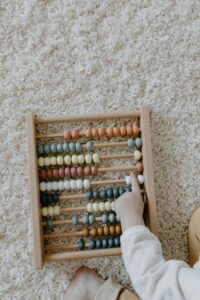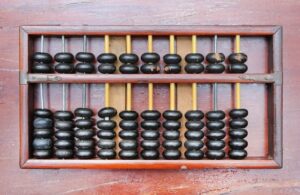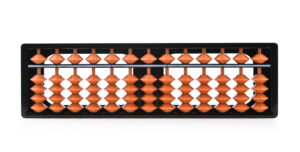The abacus is one of the oldest and most effective tools used for arithmetic calculations. It is a manual counting device that helps perform basic and complex mathematical operations such as addition, subtraction, multiplication, and division. Beyond its practical use, it is widely valued for enhancing concentration, memory, and mental calculation abilities.
History of the Abacus
- The word “abacus” originates from the Greek word “abax”, meaning “a flat surface” or “a counting board.”
- The earliest versions were simple boards or tablets with grooves where pebbles or beads were used for counting.
- It has been used for thousands of years in different cultures, including ancient Mesopotamia, China, Egypt, and Greece.
- Over time, the design evolved into the modern abacus, which includes beads strung on rods within a frame.
How It Works
- The abacus represents numbers by moving beads toward or away from the horizontal divider.
- Calculations are performed by manipulating the beads, and their final positions represent the result.
Types of Calculations
- Addition and Subtraction: Simple operations using the beads’ movements.
- Multiplication and Division: More advanced operations using positional values.
- Mental Math: Once learners are skilled, they can visualize the bead movements in their minds without using a physical abacus.
Why Use an Abacus?
- Enhances Mental Calculation: By transitioning from physical to mental manipulation of beads.
- Improves Concentration: Requires focus and precision during calculations.
- Builds Confidence in Math: Simplifies complex arithmetic for beginners.
- Boosts Cognitive Skills: Strengthens memory, problem-solving, and visualization abilities.
Modern Relevance
- While calculators and computers have replaced the abacus for everyday use, it is still widely used in:
- Education: For teaching children basic arithmetic and mental math.
- Competitions: Abacus-based mental math contests are popular worldwide.
- Brain Training: Helps adults and children improve cognitive skills.
Types of Abacus
1. The Russian Abacus (Schoty)

- Origin:
- Developed in Russia during the 16th century.
- Used extensively in shops and markets for quick calculations.
- Design:
- Single horizontal frame with rows of beads.
- No upper and lower decks, just beads strung on wires.
- Beads are counted horizontally, unlike other vertical abacuses.
- Advantages:
- Simple structure, easy to use for counting.
- Suitable for basic arithmetic like addition, subtraction, and multiplication.
- Limitations:
- Limited functionality for advanced arithmetic and mental calculations.
- Popularity: Still used in some regions but has been largely replaced by modern calculators.
2. The Chinese Abacus (Suanpan)

- Origin:
- Originated in China around 2000 years ago.
- Used for both decimal and hexadecimal calculations.
- Design:
- Rectangular frame with two sections: upper deck (2 beads per rod) and lower deck (5 beads per rod).
- Each bead represents values of 1 or 5.
- Advantages:
- Can handle complex arithmetic, including multiplication and division.
- Flexible for different numerical systems.
- Limitations:
- Slightly more complex for beginners due to the larger number of beads.
- Usage: Popular in traditional Chinese shops and businesses.
3. The Japanese Abacus (Soroban)

- Origin:
- Evolved from the Chinese abacus in the 14th century.
- Modern design standardized in the 17th century.
- Design:
- Simplified structure with one bead on the upper deck (heaven bead) and four beads on the lower deck (earth beads).
- Optimized for base-10 calculations.
- Advantages:
- Simplified design is easy for beginners to understand.
- Highly efficient for mental arithmetic training and competitions.
- Limitations:
- Limited flexibility for non-decimal calculations compared to the Chinese abacus.
- Usage: Widely used in education and mental math training programs globally.
4. Comparing the Abacuses
| Feature | Russian Abacus | Chinese Abacus (Suanpan) | Japanese Abacus (Soroban) |
|---|---|---|---|
| Ease of Use | High (Basic Use) | Medium | High |
| Arithmetic Range | Basic | Advanced | Advanced (Base-10) |
| Best for Beginners | Yes | No | Yes |
| Design Simplicity | Very Simple | Moderate | Simple |
| Popularity Today | Limited | Traditional Markets | Education and Training |
5. Which is Easiest to Start Learning?
- Japanese Abacus (Soroban): Best for beginners due to its simplified design and focus on decimal calculations.
- Chinese Abacus (Suanpan): Suitable for learners looking for flexibility in calculations.
- Russian Abacus (Schoty): A good introduction but lacks the versatility of the others.
True/False
- The word “abacus” comes from the Latin word meaning “counting board.”
- The Russian abacus is the most commonly used type in modern mental math competitions.
- The abacus enhances concentration and cognitive skills.
- The Japanese abacus (Soroban) is designed with two beads in the upper deck and five beads in the lower deck.
- The Chinese abacus (Suanpan) is more complex than the Russian abacus due to its design.
Match the Following
| Column A | Column B |
|---|---|
| 1. Origin of the word “abacus” | a. 16th century |
| 2. Russian Abacus | b. Used in education worldwide |
| 3. Chinese Abacus | c. Simplified for base-10 |
| 4. Japanese Abacus | d. “Abax” (Greek: flat surface) |
| 5. Horizontal divider | e. Separates upper and lower beads |
Fill in the Blanks
- The abacus originates from the Greek word “______,” meaning a flat surface or counting board.
- The ______ abacus is widely used for decimal and hexadecimal calculations.
- The ______ abacus is ideal for beginners due to its simplified design for base-10 calculations.
- The ______ abacus was developed in the 16th century and used in markets for quick arithmetic.
- Modern use of the abacus focuses on improving ______ math skills and cognitive development.
Answer the Following
- What are the primary benefits of using an abacus for learning mathematics?
- Compare the Russian, Chinese, and Japanese abacuses in terms of ease of use and design simplicity.
- How does using the abacus enhance mental calculation abilities?
Multiple Choice Questions (MCQs)
Which of the following is the origin of the word “abacus”?
- a) Latin
- b) Greek
- c) Chinese
- d) Russian
What is the main feature of the Japanese abacus (Soroban)?
- a) It has beads arranged horizontally.
- b) It has one upper bead and four lower beads on each rod.
- c) It is used for hexadecimal calculations.
- d) It is the most complex abacus type.
Which type of abacus is most suited for teaching beginners?
- a) Russian Abacus
- b) Chinese Abacus
- c) Japanese Abacus
- d) None of the above
Which type of abacus allows calculations in both decimal and hexadecimal systems?
- a) Japanese Abacus
- b) Chinese Abacus
- c) Russian Abacus
- d) All of the above
In modern times, the abacus is primarily used for:
- a) Quick calculations in markets.
- b) Competitions and education.
- c) Replacing calculators.
- d) None of the above.
Match the Abacus Types with Their Features
| Abacus Type | Features |
|---|---|
| 1. Russian Abacus (Schoty) | a. Used for decimal and hexadecimal calculations. |
| 2. Chinese Abacus (Suanpan) | b. Simplified design, one upper bead, four lower beads. |
| 3. Japanese Abacus (Soroban) | c. Rows of beads counted horizontally. |
True/False Answers
- False – The word “abacus” comes from the Greek word “abax,” not Latin.
- False – The Japanese abacus (Soroban) is most commonly used in modern mental math competitions.
- True
- False – The Japanese abacus has one bead on the upper deck and four beads on the lower deck.
- True
Match the Following Answers
| Column A | Column B |
|---|---|
| 1. Origin of the word “abacus” | d. “Abax” (Greek: flat surface) |
| 2. Russian Abacus | a. 16th century |
| 3. Chinese Abacus | e. Used in education worldwide |
| 4. Japanese Abacus | c. Simplified for base-10 |
| 5. Horizontal divider | b. Separates upper and lower beads |
Fill in the Blanks Answers
- The abacus originates from the Greek word “abax,” meaning a flat surface or counting board.
- The Chinese abacus is widely used for decimal and hexadecimal calculations.
- The Japanese abacus is ideal for beginners due to its simplified design for base-10 calculations.
- The Russian abacus was developed in the 16th century and used in markets for quick arithmetic.
- Modern use of the abacus focuses on improving mental math skills and cognitive development.
Answer the Following
Primary Benefits of the Abacus:
- Enhances mental calculation.
- Improves concentration and focus.
- Builds confidence in math.
- Strengthens memory, problem-solving, and visualization skills.
Comparison of Abacuses:
- Russian Abacus: Simple design, easy for basic arithmetic but limited in advanced operations.
- Chinese Abacus: Flexible for decimal and hexadecimal systems but more complex for beginners.
- Japanese Abacus: Simplified, efficient for base-10 calculations, making it best for beginners and mental math training.
Enhancing Mental Calculation:
- Learners transition from physical manipulation of beads to visualizing their movements mentally.
- This practice strengthens memory and speeds up arithmetic problem-solving.
Multiple Choice Questions (MCQs) Answers
- b) Greek
- b) It has one upper bead and four lower beads on each rod.
- c) Japanese Abacus
- b) Chinese Abacus
- b) Competitions and education
Match the Abacus Types with Their Features Answers
| Abacus Type | Features |
|---|---|
| 1. Russian Abacus (Schoty) | c. Rows of beads counted horizontally. |
| 2. Chinese Abacus (Suanpan) | a. Used for decimal and hexadecimal calculations. |
| 3. Japanese Abacus (Soroban) | b. Simplified design, one upper bead, four lower beads. |
